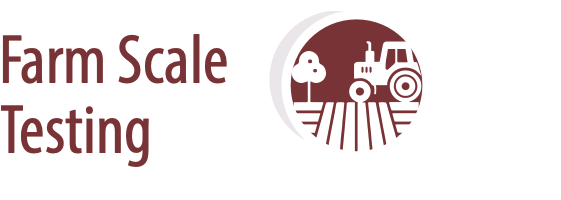Daryl Domitruk, PhD. P.Ag, Executive Director, MPSG
REPORTING WITH GREATER detail about the research in which MPSG invests growers’ money is one way for us to remain accountable to members.
Our publisher, Burr Forest Group, has produced a picture of how solutions are built through a sequence of research phases.
THE CHALLENGE
We start by identifying a challenge. Agronomists in the field observe complex interactions among soil, water, and genetics then stir in the observations, opinions, and analysis of the grower.
A seasoned agronomist uses their professional judgement to weigh the evidence and zero in on the challenge. That’s MPSG’s first point of accountability – using members’ check-off dollars to employ skilled agronomists and provide them with the tools to survey members’ crops. Part of their job is to sift out challenges that require research to find a solution. MPSG agronomists can readily initiate research projects tailored to members’ needs.
In 2023, MPSG agronomists sampled soil and roots from over 200 fields. We’re gaining a handle on the challenge posed by root rot in pea and soybean crops and the emerging presence of soybean cyst nematode. See MPSG’s social media and Pulse Beat – Science Edition for results.
AFTER THE CHALLENGE: THE ROAD TO FARMER ADOPTION
At which phase MPSG invests depends on how much mystery shrouds the challenge. The deeper the mystery, the further upstream we must invest, and the longer it will take to get farmers a solution. A good example of this situation is root rot.
ROOT ROT
By the time a crop displays symptoms of root rot, it’s too late. Even if there were an available rescue treatment, root rot pathogens are endemic in the soil and capable of resisting treatment. Root rot is such a significant research challenge, it has brought MPSG and its sister organizations together to figure out the fundamentals of the pathogens and their interaction with plants and soil.

THE FUNDAMENTALS
Since 2018, MPSG has spent about $960,000 on root rot research. Of that figure, about $440,000 has been spent on the fundamentals. For plant breeders to acquire the ability to select resistant varieties, we first must enlist plant pathologists and soil microbiologists
to clearly identify the pathogens and figure out their behaviour in soil. Simultaneously, we must support scientists whose trade is genetics, genomics, and bioinformatics to isolate genes for resistance. Plant breeders are waiting downstream to learn how many genes exist, where they are focused on chromosomes and how their actions are triggered.
In this phase, the research does not appear to be connected to grain farming. The work is focused on the invisible world of plant cells and single cell microbes, the genes within those cells, and even
the gene’s building blocks – nucleic acids. Nevertheless, this phase is critical to the grain farm. Steps towards cost- effective solutions like resistant varieties, higher yields, and lower chemical use don’t happen without knowledge of the fundamentals. MPSG reports to members as projects progress through this phase even though, for most of us, the highly specialized language of upstream science may be out of reach.
AAFC Brandon developed techniques for detecting and quantifying root rot in peas. This helped assess the risk of Aphanomyces in Manitoba fields. The same project also screened newly crossed pea lines for the presence of DNA segments correlated to root rot resistance.
Laval University developed a technique to identify specific races of Phytophthora root rot in soybeans. MPSG uses the method supplied by a spin-off of the Laval project, to confirm if resistance reported by seed companies matches the race of pathogen present in Manitoba.
AAFC Lethbridge developed improved methods for screening peas for root rot resistance. The results emphasized that at present only partial genetic resistance is achievable.
University of Manitoba reported that members of the Fusarium family of pathogens that infect wheat also infect soybean and cause root rot.

STEPS FORWARD THROUGH APPLIED RESEARCH
Within the ag community, we’ve reserved the “applied” designation for a phase of projects that get us closer to the farm- gate solution. Most plant breeders and research agronomists practice their craft in this phase. MPSG has spent about $520,000 to date examining root rot through experiments in crop rotation, seeding systems, drainage effects, etc. The results inform fundamental research and shed light on the effect farm practices have on root rot. Because we often want to test many different practices at once, we use the efficient method known as “small-plot research.” Due to the strong influence of soil and weather on crop disease, MPSG insists on conducting such studies at a range of locations. MPSG vigorously extends results of projects in this phase as most farmers find the results at least somewhat relatable.
Also, during this phase plant breeders will be handed information on resistance genes so they can create improved disease resistant varieties. As most people know, this can take a decade. Testing the staying power of genetic resistance requires intense screening across contrasting environments. Plant breeding is a combination of science and art as the eye of the breeder is as important a tool
as any.
Members should know that MPSG is a relatively small contributor to the plant breeding phase of research. The reasons are a) our main crop, soybeans, is largely developed by the private sector, and b) dry pea breeding is conducted by publicly funded labs in Saskatchewan and Alberta – where the majority of pea production and pea research resides. In contrast, dry bean improvement is a significant element in MPSG’s research portfolio. Leadership of the breeding program, including the search for root rot resistance, at AAFC Morden has recently been brought under the program at AAFC Harrow in Ontario.
AAFC Brandon has established that growing pea and soybean in rotation has no impact on root rot, at least in the short term. The work has set the basis for long-term experiments to gauge if farm practice has any bearing on root rot management.
Research from the University of Manitoba revealed that as a low residue crop, soybeans benefit from a higher residue preceding crop such as corn. There appears to be positive effect on soil health and the activity of N-fixing microbes.
University of Saskatchewan’s pea breeding program managed to incorporate sequences of genes that impart partial resistance to Aphanomyces root rot into pea lines that also have desirable traits including semi-leafless leaf type, white flower colour, powdery mildew resistance, and round/smooth seed shape.
The MPSG/University of Manitoba Agronomist-in-Residence program is in the midst of an eight-year crop rotation experiment to determine if extending the interval between pea crops effects the severity of root rot.

FARM SCALE TESTING: PROOF OF PROGRESS
MPSG has an advanced ability to test new practices, varieties, and technologies on members’ farms. For potential solutions to reach the farm scale testing phase, things had to go right in previous phases. Still, due to the financial risks involved, scaled up on-farm testing can verify a solution’s practical value under specific soil and weather conditions and within a farm’s limits of time, labour, equipment, and money. By this phase, there are usually only two or three solutions to compare. Generally, farmers want to know if the new option is superior to the previous standard. Contrasting varieties, chemical or biological treatments, and variations in rotation or soil management are excellent candidates for on-farm testing. About 40 per cent of MPSG’s research budget is dedicated to on-farm tests.
Approaching 600 trials conducted across Manitoba, MPSG’s On-Farm Network has acquired soil sampling and digital imaging tools to begin extracting more detailed information from trials on famers’ fields. Over time this will include more comprehensive tracking of root rot in response to solutions developed through the phased approach to research.

SUCCESS? IT’S TIME TO DEMONSTRATE
Mostly reserved for improved crop protection products, varieties, or equipment, the demonstration of a scientifically proven solution is a key part of extension. Comparisons to a standard are often not required as the new option has already established its superiority in previous phases. MPSG is often found looking over the shoulder of members as they try solutions and apply their own subjective assessments. These experiences prepare our agronomists for the next cycle of phased research projects.
Since 2018 MPSG has partnered on nation-wide root rot projects worth over $10 million. That’s about a 10-to-1 leverage of our growers’ dollars with governments being a key contributor. We remain some distance away from solutions so work is expected to continue into the foreseeable future.



